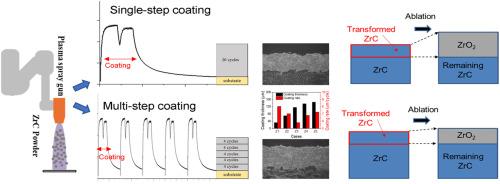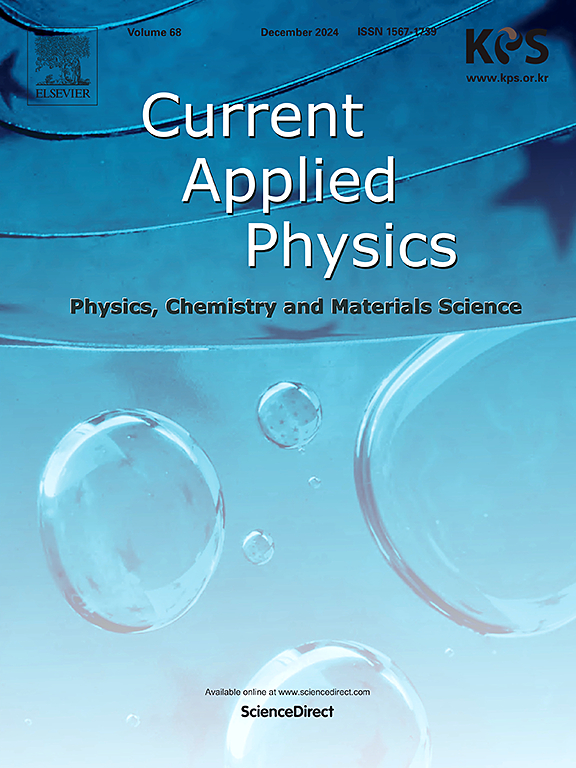Structural properties and ablation behaviors of homogeneous ZrC multi-layer coated on carbon/carbon composites via a multi-step vacuum plasma spray coating process
IF 3.1
4区 物理与天体物理
Q3 MATERIALS SCIENCE, MULTIDISCIPLINARY
引用次数: 0
Abstract
Ablation-resistant zirconium carbide (ZrC) layers were coated onto carbon/carbon (C/C) composites using vacuum plasma spraying. The structural and ablative characteristics of ZrC layers applied in single-versus multi-step coating processes were compared. An increase in the number of coating cycles from 4 to 20 in single-step coating increased the ZrC layer's thickness from 32.3 μm to 116.2 μm even though the coating rate per cycle was reduced from 8.1 μm/cycle to 5.8 μm/cycle. By increasing the number of cycles, the substrate surface was continuously heated, enhancing the lateral spread of molten droplets and improving the porosity and hardness of the ZrC layer. On the other hand, multi-step coating, involving repetition of the single-step process, yielded a 20% thickness increase of ZrC layers with a higher coating rate while maintaining comparable mechanical properties despite an identical total number of coating cycles. Furthermore, the multi-step-coated layers showed better thermal oxidation resistance than the single-step-coated layers due to the formation of ZrC/ZrC interfaces having larger grain boundaries and the thicker ZrCxOy layers, effectively barring oxygen diffusion. The multi-step coating of identical ZrC layers suggested the better thermal oxidation resistant protection way for C/C composite without the reduction of coated layer's properties.

碳/碳复合材料表面多步真空等离子喷涂均匀ZrC多层膜的组织性能和烧蚀行为
采用真空等离子喷涂技术在碳/碳(C/C)复合材料表面镀覆抗烧蚀碳化锆(ZrC)层。比较了单步镀和多步镀ZrC层的结构和烧蚀特性。在单步涂层中,涂层循环次数从4次增加到20次,使ZrC层的厚度从32.3 μm增加到116.2 μm,而涂层速率从8.1 μm/cycle降低到5.8 μm/cycle。通过增加循环次数,基材表面不断受热,增强了熔滴的横向扩散,提高了ZrC层的孔隙率和硬度。另一方面,在重复单步工艺的情况下,多步涂层使ZrC层的厚度增加了20%,涂层率更高,同时在涂层循环次数相同的情况下保持了相当的机械性能。由于ZrC/ZrC界面的晶界更大,ZrCxOy层更厚,有效地阻止了氧的扩散,因此多级包覆层比单级包覆层具有更好的抗热氧化性能。在不降低涂层性能的情况下,对相同的ZrC层进行多步涂覆,为C/C复合材料提供了更好的抗热氧化保护方式。
本文章由计算机程序翻译,如有差异,请以英文原文为准。
求助全文
约1分钟内获得全文
求助全文
来源期刊

Current Applied Physics
物理-材料科学:综合
CiteScore
4.80
自引率
0.00%
发文量
213
审稿时长
33 days
期刊介绍:
Current Applied Physics (Curr. Appl. Phys.) is a monthly published international journal covering all the fields of applied science investigating the physics of the advanced materials for future applications.
Other areas covered: Experimental and theoretical aspects of advanced materials and devices dealing with synthesis or structural chemistry, physical and electronic properties, photonics, engineering applications, and uniquely pertinent measurement or analytical techniques.
Current Applied Physics, published since 2001, covers physics, chemistry and materials science, including bio-materials, with their engineering aspects. It is a truly interdisciplinary journal opening a forum for scientists of all related fields, a unique point of the journal discriminating it from other worldwide and/or Pacific Rim applied physics journals.
Regular research papers, letters and review articles with contents meeting the scope of the journal will be considered for publication after peer review.
The Journal is owned by the Korean Physical Society.
 求助内容:
求助内容: 应助结果提醒方式:
应助结果提醒方式:


